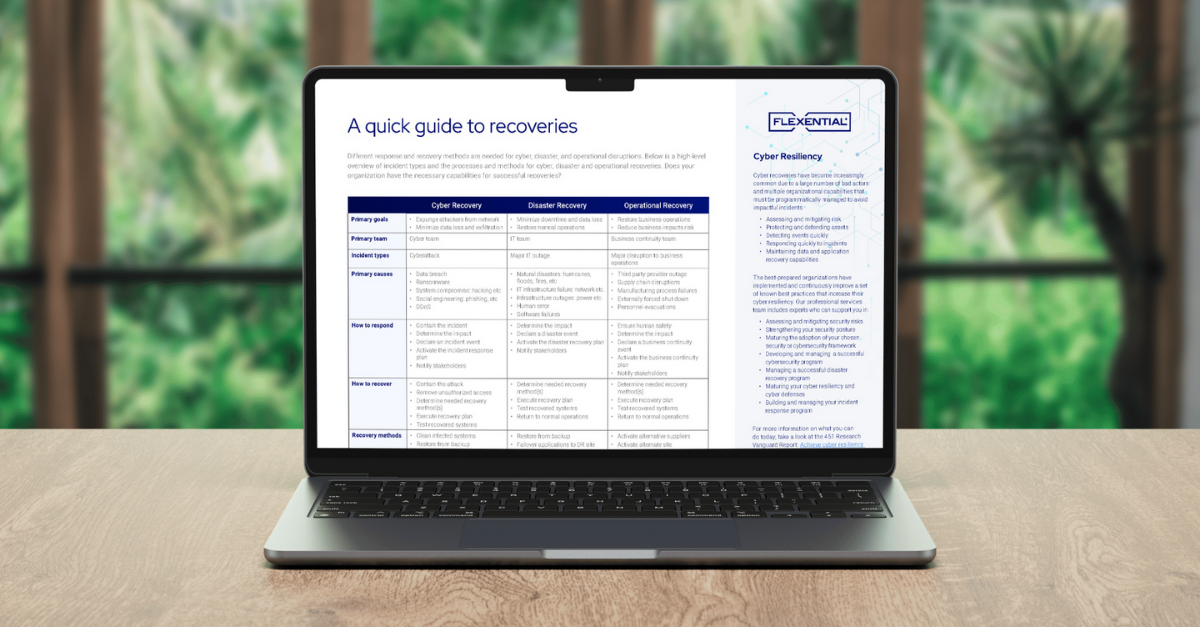Implementing effective data protection strategies for businesses
Data protection is critical for businesses, and the threat of breaches and system disruption poses substantial risk. A staggering 74% of all data breaches involve a human element, such as phishing, and 69% of employees admit to deliberately neglecting security controls. This alarming reality highlights the importance of a robust disaster recovery (DR) plan.

Data protection isn't just about protecting against bad actors; businesses are increasingly dependent on their IT systems, and any disruption can lead to considerable losses, damaging revenue and reputation. A well-structured DR plan ensures the swift and efficient restoration of critical applications and data following a disaster, thereby minimizing downtime and disruption.
A recent webinar featuring industry experts Will Bass and Clay Mathre focused on the importance of mastering data protection in the face of increasing cyber threats. Here are the key takeaways from their discussion and why finding the right balance between business requirements, cost, and effort is crucial in data protection.
"Mastering data protection is crucial in today's digital landscape, where 74% of all data breaches involve a human element. Companies must align the right tools with the right workloads, understanding all components of a workload, dependencies, and service level agreements. It's about finding the right balance between what the business requires and the cost and effort to maintain it. Remember, not all workloads belong in the highest tier of protection due to the increased cost and complexity."
The importance of strengthening business continuity
Data breaches pose a significant threat to businesses, with companies only managing to recover approximately 61% of their encrypted data post-incident. This statistic underscores the importance of implementing effective data protection tools to ensure business continuity.
Not all data necessitates high availability, backups, or disaster recovery services. Therefore, aligning the appropriate tool with the corresponding workload is crucial for prompt and efficient data recovery in case of a disaster.
A variety of data protection tools exist, such as disaster recovery solutions, native replication, backups, and clustered environments. The selection of these tools is contingent upon the specific data requiring protection and the unique demands of the business.
Understanding the components of a workload and their interdependencies is vital to designing an effective disaster recovery solution. Additionally, the comprehension of service level agreements (SLAs) and protection level agreements (PLAs) is key, as they dictate the speed at which data recovery should occur.
Understanding workloads, dependencies, SLAs, and PLAs allows one to categorize them into various tiers based on their recovery time objective (RTO) and recovery point objective (RPO). The RTO and RPO define the time taken to recover data and the age of the data, respectively. Different applications have distinct requirements; understanding these is instrumental in selecting the appropriate data protection tool.
Implementation of a data protection strategy involves a sequence of steps. Initially, it's essential to correctly set up networking services on both the production and disaster recovery sides to prevent configuration drift. Subsequently, authentication services should be initiated, followed by database services. Once these are operational, application services can be launched, which serve as the primary servers for customers and employees.
Strategies for developing an effective disaster recovery plan
Key services, while vital, are not the only ones that require safeguarding. Other essential but non-critical services, such as HR and accounting servers, also need protection. They may not be as time-sensitive as application services, but their security is equally important. Additional services like dev environments, testing environments, and archival storage, though not as critical, still require protection.
A crucial aspect of developing a DR plan is stratifying applications. The importance of applications varies—some are more crucial to business operations than others. Identifying these vital applications and prioritizing them in the DR plan is essential. This process involves striking a balance between recovery time objectives (RTOs), recovery point objectives (RPOs), and the cost and complexity of the DR solution.
For instance, a basic DR environment may consist of a limited number of virtual servers; all safeguarded using VMware ESXi. The vital applications are secured using a DR application, ensuring their quick restoration in case of a disaster. This method is cost-effective and relatively easy to test and maintain.
For larger or more complex environments, a more advanced DR solution might be necessary. This could involve a combination of virtual and physical servers and even cloud services. In such a scenario, vital services like Active Directory and SQL servers might be replicated in real time, guaranteeing their constant readiness for restoration in case of a disaster. Other less critical services might be secured using a DR application or even restored from backups.
In the most intricate scenarios, a hybrid cloud model might be utilized. This model distributes the DR solution across multiple locations and providers, ensuring business continuity even if one site fails. Though effective, this method can be complex, costly, and may require skilled network engineering.
Understanding workloads is the key
In conclusion, data protection is undeniably complex and requires meticulous planning and execution. It goes beyond having the right tools; it necessitates understanding your workloads, their interdependencies, and your business requirements. A tiered approach to data protection helps shield your most critical services, manage costs, and control complexity. The overarching aim is not just data recovery but to restore it in a way that enables your business to operate efficiently and effectively.
Equally important is the crafting of a comprehensive disaster recovery (DR) plan. This involves the identification of key applications, striking the right balance between Recovery Time Objectives (RTOs) and Recovery Point Objectives (RPOs), and selecting the appropriate DR solution tailored to your business needs. This could range from a simple VMware ESXi setup to a complex hybrid cloud model. Regardless of the model, the goal remains consistent: to ensure speedy and efficient recovery in the wake of a disaster, thus minimizing downtime and disruption.
Be sure to check out the entire webinar, Mastering data protection: Insights for implementing the right data protection strategy for your workloads, now available on-demand.







